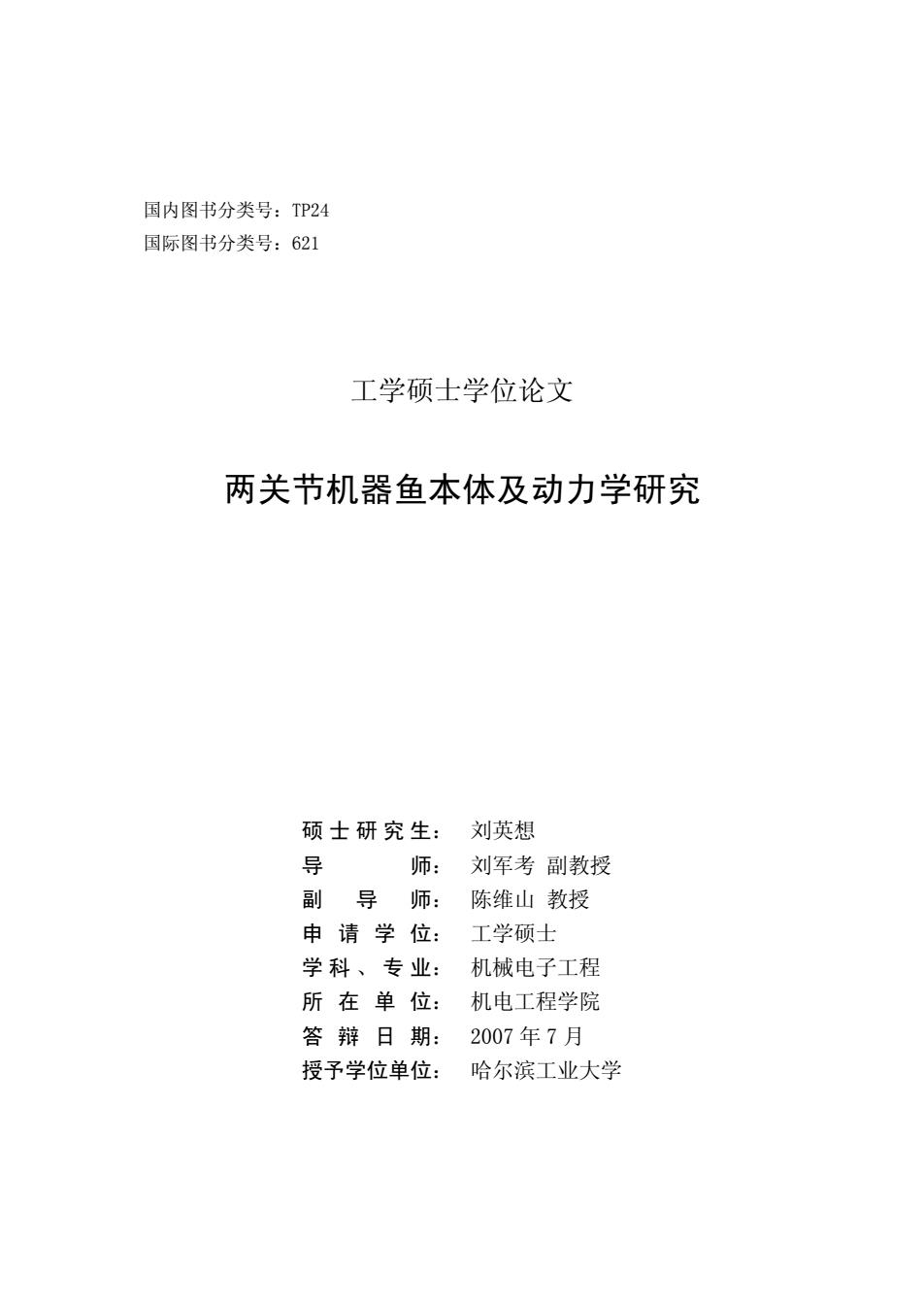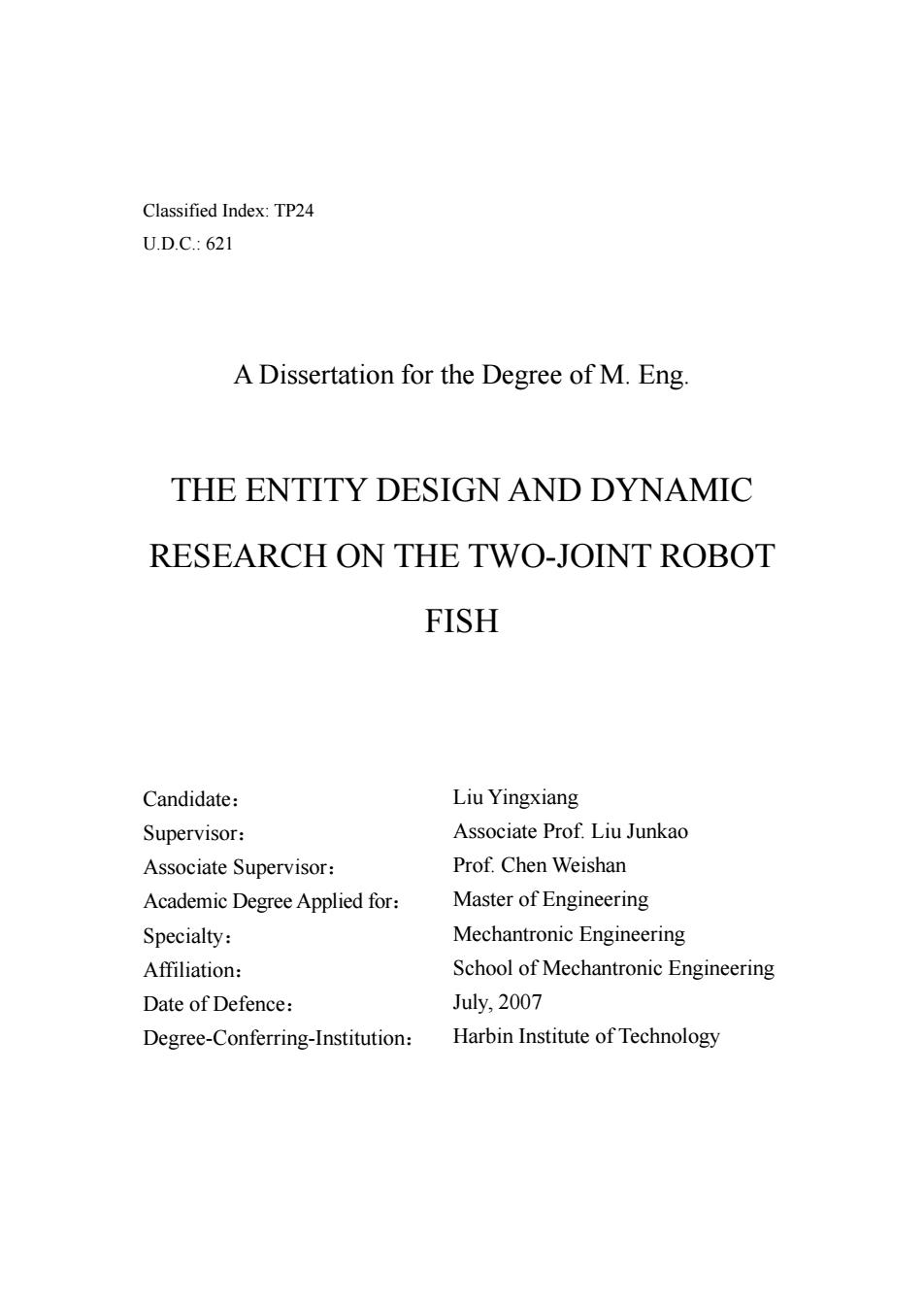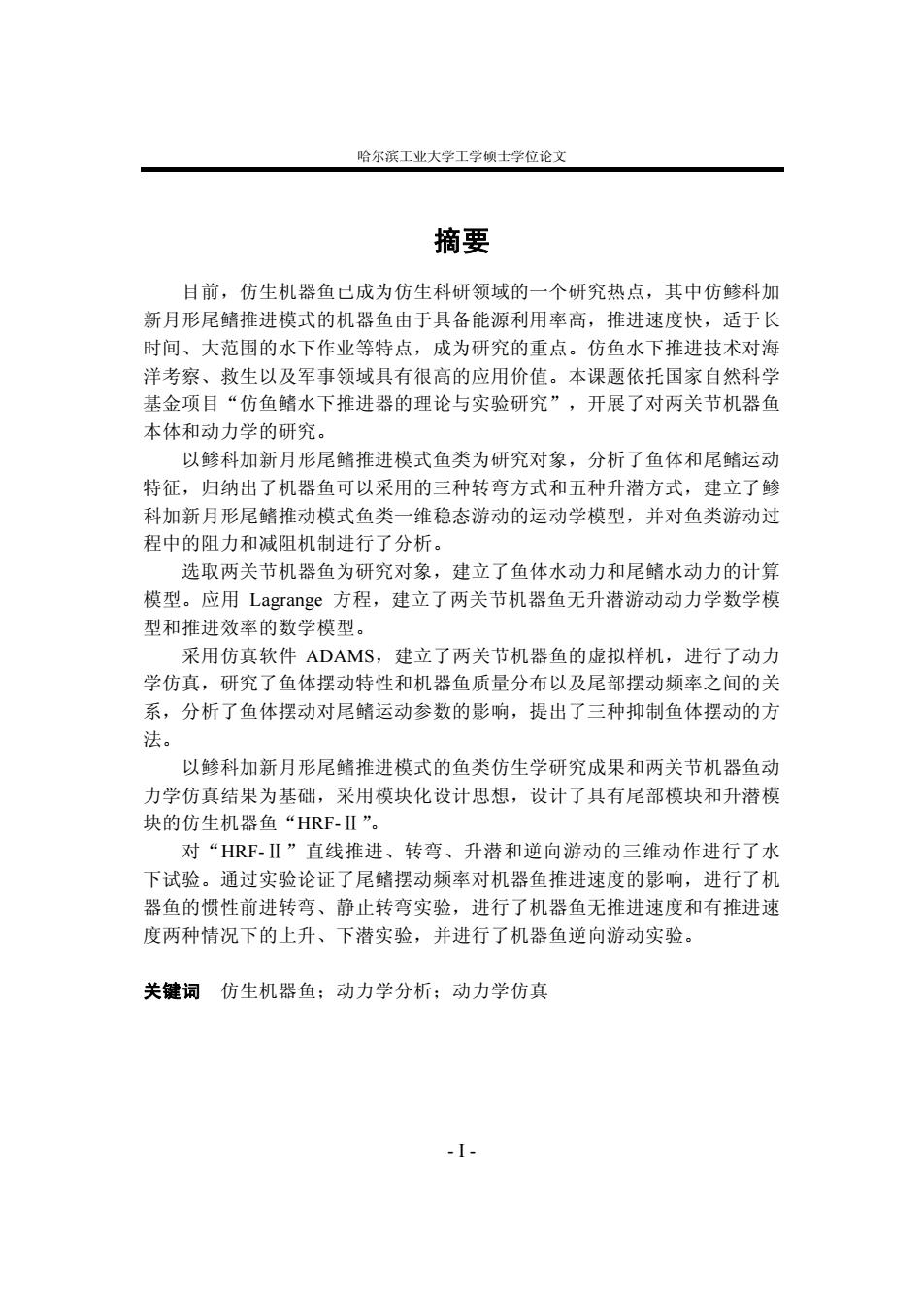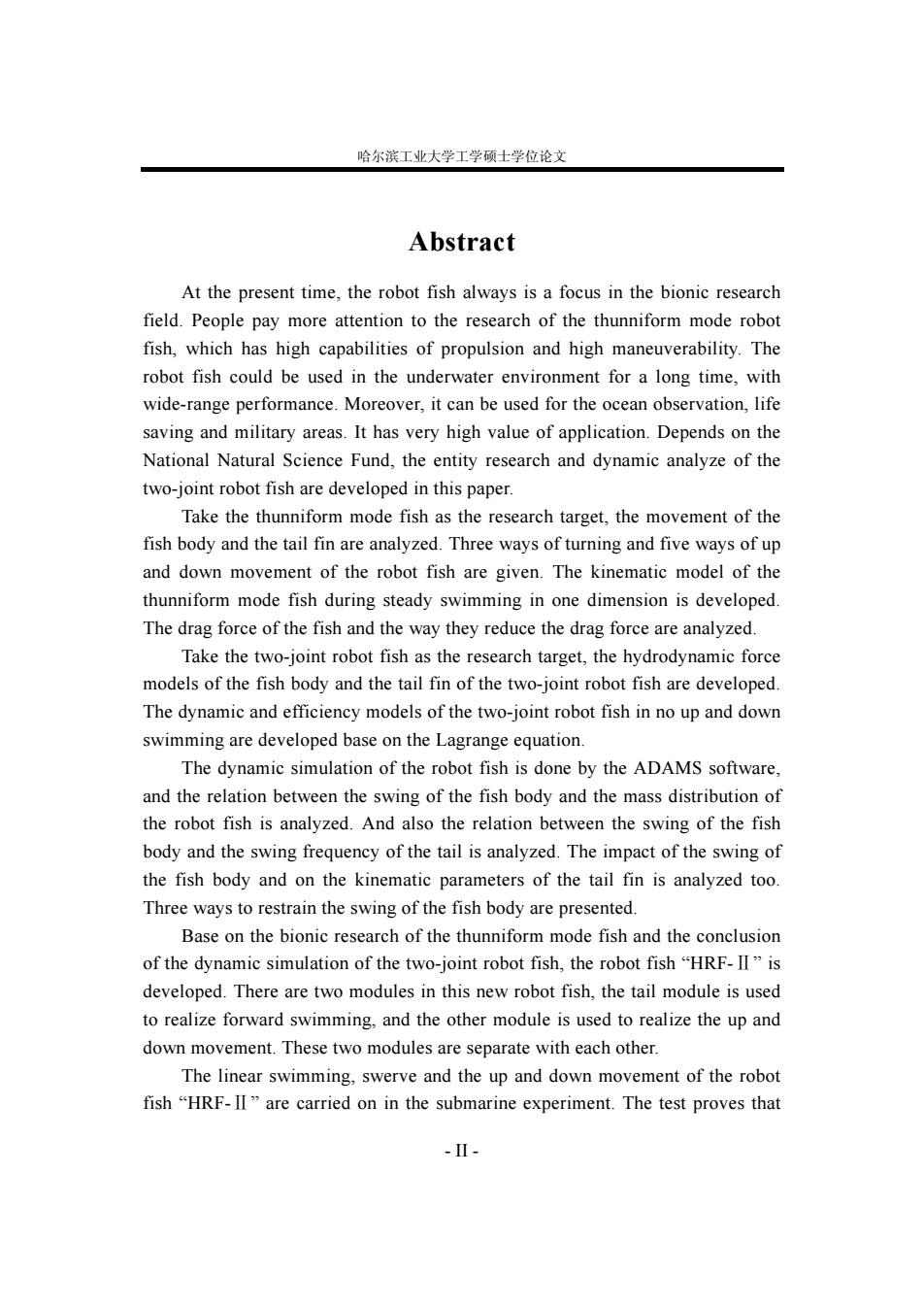
工学硕士学位论文 两关节机器鱼本体及动力学研究 刘英想 哈尔滨工业大学 2007年7月
工学硕士学位论文 两关节机器鱼本体及动力学研究 刘英想 哈尔滨工业大学 2007 年 7 月

国内图书分类号:TP24 国际图书分类号:621 工学硕士学位论文 两关节机器鱼本体及动力学研究 硕士研究生: 刘英想 导 师: 刘军考副教授 副导 师: 陈维山教授 申请学位: 工学硕士 学科、专业: 机械电子工程 所在单位: 机电工程学院 答辩日期: 2007年7月 授予学位单位: 哈尔滨工业大学
国内图书分类号:TP24 国际图书分类号:621 工学硕士学位论文 两关节机器鱼本体及动力学研究 硕 士 研 究 生: 刘英想 导 师: 刘军考 副教授 副 导 师: 陈维山 教授 申 请 学 位: 工学硕士 学 科 、 专 业: 机械电子工程 所 在 单 位: 机电工程学院 答 辩 日 期: 2007 年 7 月 授予学位单位: 哈尔滨工业大学

Classified Index:TP24 U.D.C:621 A Dissertation for the Degree of M.Eng THE ENTITY DESIGN AND DYNAMIC RESEARCH ON THE TWO-JOINT ROBOT FISH Candidate: Liu Yingxiang Supervisor: Associate Prof.Liu Junkao Associate Supervisor: Prof.Chen Weishan Academic Degree Applied for: Master of Engineering Specialty: Mechantronic Engineering Affiliation: School of Mechantronic Engineering Date of Defence: July,2007 Degree-Conferring-Institution: Harbin Institute of Technology
Classified Index: TP24 U.D.C.: 621 A Dissertation for the Degree of M. Eng. THE ENTITY DESIGN AND DYNAMIC RESEARCH ON THE TWO-JOINT ROBOT FISH Candidate: Liu Yingxiang Supervisor: Associate Prof. Liu Junkao Associate Supervisor: Prof. Chen Weishan Academic Degree Applied for: Master of Engineering Specialty: Mechantronic Engineering Affiliation: School of Mechantronic Engineering Date of Defence: July, 2007 Degree-Conferring-Institution: Harbin Institute of Technology

哈尔滨工业大学工学硕士学位论文 摘要 目前,仿生机器鱼己成为仿生科研领域的一个研究热点,其中仿鲹科加 新月形尾鳍推进模式的机器鱼由于具备能源利用率高,推进速度快,适于长 时间、大范围的水下作业等特点,成为研究的重点。仿鱼水下推进技术对海 洋考察、救生以及军事领域具有很高的应用价值。本课题依托国家自然科学 基金项目“仿鱼鳍水下推进器的理论与实验研究”,开展了对两关节机器鱼 本体和动力学的研究。 以鲹科加新月形尾鳍推进模式鱼类为研究对象,分析了鱼体和尾鳍运动 特征,归纳出了机器鱼可以采用的三种转弯方式和五种升潜方式,建立了鲹 科加新月形尾鳍推动模式鱼类一维稳态游动的运动学模型,并对鱼类游动过 程中的阻力和减阻机制进行了分析。 选取两关节机器鱼为研究对象,建立了鱼体水动力和尾鳍水动力的计算 模型。应用Lagrange方程,建立了两关节机器鱼无升潜游动动力学数学模 型和推进效率的数学模型。 采用仿真软件ADAMS,建立了两关节机器鱼的虚拟样机,进行了动力 学仿真,研究了鱼体摆动特性和机器鱼质量分布以及尾部摆动频率之间的关 系,分析了鱼体摆动对尾鳍运动参数的影响,提出了三种抑制鱼体摆动的方 法。 以鲹科加新月形尾鳍推进模式的鱼类仿生学研究成果和两关节机器鱼动 力学仿真结果为基础,采用模块化设计思想,设计了具有尾部模块和升潜模 块的仿生机器鱼“HRF-IⅡ”。 对“HRF-Ⅱ”直线推进、转弯、升潜和逆向游动的三维动作进行了水 下试验。通过实验论证了尾鳍摆动频率对机器鱼推进速度的影响,进行了机 器鱼的惯性前进转弯、静止转弯实验,进行了机器鱼无推进速度和有推进速 度两种情况下的上升、下潜实验,并进行了机器鱼逆向游动实验。 关键词仿生机器鱼;动力学分析:动力学仿真 -I-
哈尔滨工业大学工学硕士学位论文 摘要 目前,仿生机器鱼已成为仿生科研领域的一个研究热点,其中仿鲹科加 新月形尾鳍推进模式的机器鱼由于具备能源利用率高,推进速度快,适于长 时间、大范围的水下作业等特点,成为研究的重点。仿鱼水下推进技术对海 洋考察、救生以及军事领域具有很高的应用价值。本课题依托国家自然科学 基金项目“仿鱼鳍水下推进器的理论与实验研究”,开展了对两关节机器鱼 本体和动力学的研究。 以鲹科加新月形尾鳍推进模式鱼类为研究对象,分析了鱼体和尾鳍运动 特征,归纳出了机器鱼可以采用的三种转弯方式和五种升潜方式,建立了鲹 科加新月形尾鳍推动模式鱼类一维稳态游动的运动学模型,并对鱼类游动过 程中的阻力和减阻机制进行了分析。 选取两关节机器鱼为研究对象,建立了鱼体水动力和尾鳍水动力的计算 模型。应用 Lagrange 方程,建立了两关节机器鱼无升潜游动动力学数学模 型和推进效率的数学模型。 采用仿真软件 ADAMS,建立了两关节机器鱼的虚拟样机,进行了动力 学仿真,研究了鱼体摆动特性和机器鱼质量分布以及尾部摆动频率之间的关 系,分析了鱼体摆动对尾鳍运动参数的影响,提出了三种抑制鱼体摆动的方 法。 以鲹科加新月形尾鳍推进模式的鱼类仿生学研究成果和两关节机器鱼动 力学仿真结果为基础,采用模块化设计思想,设计了具有尾部模块和升潜模 块的仿生机器鱼“HRF-Ⅱ”。 对“HRF-Ⅱ”直线推进、转弯、升潜和逆向游动的三维动作进行了水 下试验。通过实验论证了尾鳍摆动频率对机器鱼推进速度的影响,进行了机 器鱼的惯性前进转弯、静止转弯实验,进行了机器鱼无推进速度和有推进速 度两种情况下的上升、下潜实验,并进行了机器鱼逆向游动实验。 关键词 仿生机器鱼;动力学分析;动力学仿真 - I -

哈尔滨工业大学工学硕士学位论文 Abstract At the present time,the robot fish always is a focus in the bionic research field.People pay more attention to the research of the thunniform mode robot fish,which has high capabilities of propulsion and high maneuverability.The robot fish could be used in the underwater environment for a long time,with wide-range performance.Moreover,it can be used for the ocean observation,life saving and military areas.It has very high value of application.Depends on the National Natural Science Fund,the entity research and dynamic analyze of the two-joint robot fish are developed in this paper. Take the thunniform mode fish as the research target,the movement of the fish body and the tail fin are analyzed.Three ways of turning and five ways of up and down movement of the robot fish are given.The kinematic model of the thunniform mode fish during steady swimming in one dimension is developed. The drag force of the fish and the way they reduce the drag force are analyzed. Take the two-joint robot fish as the research target,the hydrodynamic force models of the fish body and the tail fin of the two-joint robot fish are developed. The dynamic and efficiency models of the two-joint robot fish in no up and down swimming are developed base on the Lagrange equation. The dynamic simulation of the robot fish is done by the ADAMS software, and the relation between the swing of the fish body and the mass distribution of the robot fish is analyzed.And also the relation between the swing of the fish body and the swing frequency of the tail is analyzed.The impact of the swing of the fish body and on the kinematic parameters of the tail fin is analyzed too. Three ways to restrain the swing of the fish body are presented. Base on the bionic research of the thunniform mode fish and the conclusion of the dynamic simulation of the two-joint robot fish,the robot fish"HRF-II"is developed.There are two modules in this new robot fish,the tail module is used to realize forward swimming,and the other module is used to realize the up and down movement.These two modules are separate with each other The linear swimming,swerve and the up and down movement of the robot fish "HRF-II"are carried on in the submarine experiment.The test proves that -Ⅱ-
哈尔滨工业大学工学硕士学位论文 Abstract At the present time, the robot fish always is a focus in the bionic research field. People pay more attention to the research of the thunniform mode robot fish, which has high capabilities of propulsion and high maneuverability. The robot fish could be used in the underwater environment for a long time, with wide-range performance. Moreover, it can be used for the ocean observation, life saving and military areas. It has very high value of application. Depends on the National Natural Science Fund, the entity research and dynamic analyze of the two-joint robot fish are developed in this paper. Take the thunniform mode fish as the research target, the movement of the fish body and the tail fin are analyzed. Three ways of turning and five ways of up and down movement of the robot fish are given. The kinematic model of the thunniform mode fish during steady swimming in one dimension is developed. The drag force of the fish and the way they reduce the drag force are analyzed. Take the two-joint robot fish as the research target, the hydrodynamic force models of the fish body and the tail fin of the two-joint robot fish are developed. The dynamic and efficiency models of the two-joint robot fish in no up and down swimming are developed base on the Lagrange equation. The dynamic simulation of the robot fish is done by the ADAMS software, and the relation between the swing of the fish body and the mass distribution of the robot fish is analyzed. And also the relation between the swing of the fish body and the swing frequency of the tail is analyzed. The impact of the swing of the fish body and on the kinematic parameters of the tail fin is analyzed too. Three ways to restrain the swing of the fish body are presented. Base on the bionic research of the thunniform mode fish and the conclusion of the dynamic simulation of the two-joint robot fish, the robot fish “HRF-Ⅱ” is developed. There are two modules in this new robot fish, the tail module is used to realize forward swimming, and the other module is used to realize the up and down movement. These two modules are separate with each other. The linear swimming, swerve and the up and down movement of the robot fish “HRF-Ⅱ” are carried on in the submarine experiment. The test proves that - II -